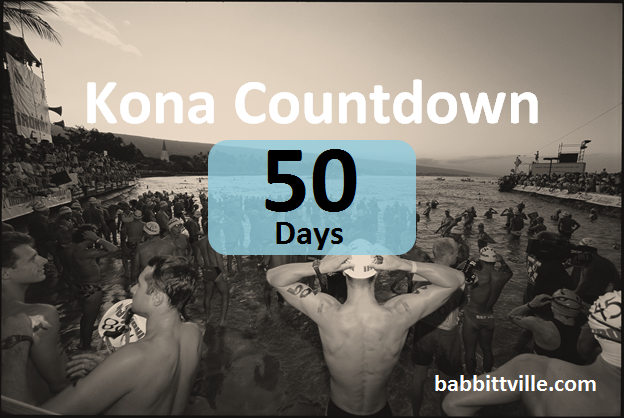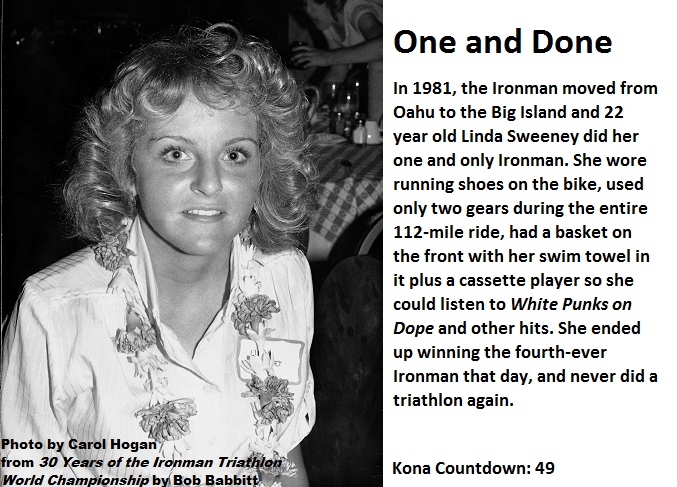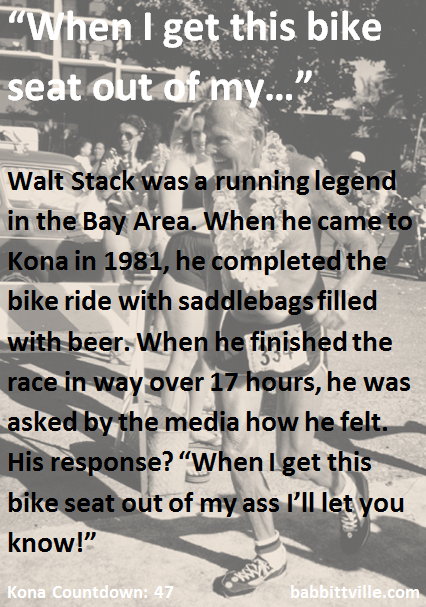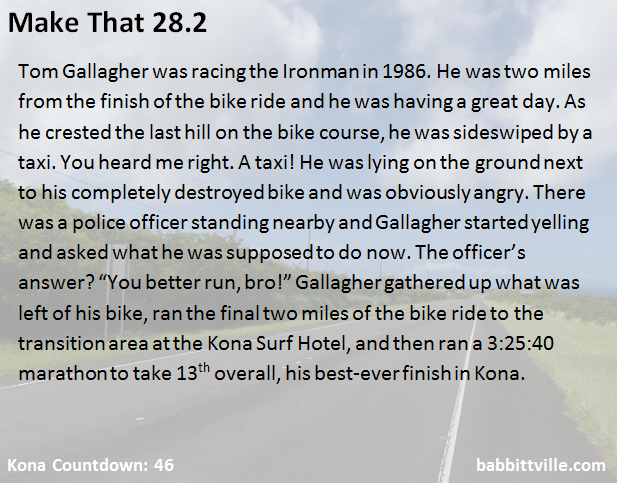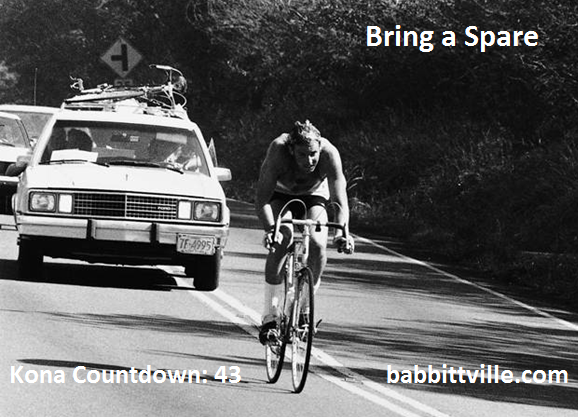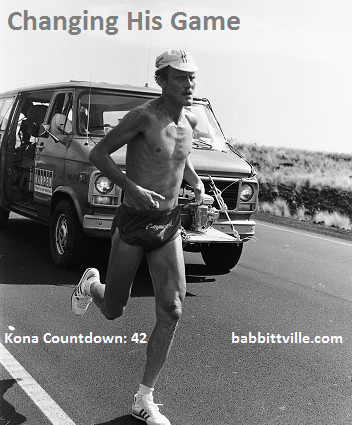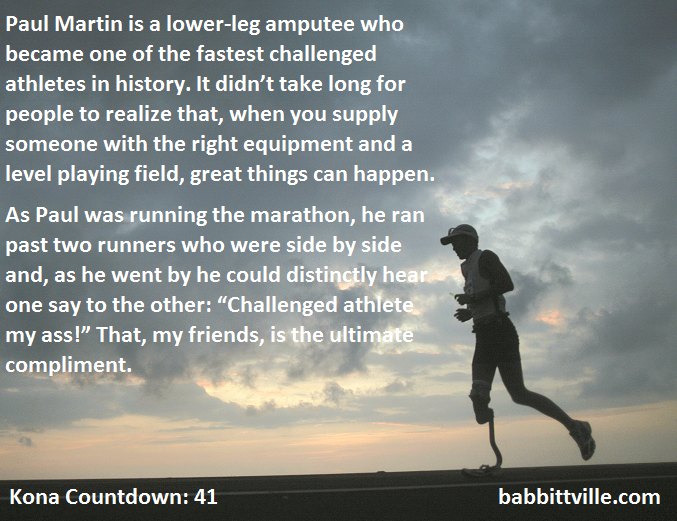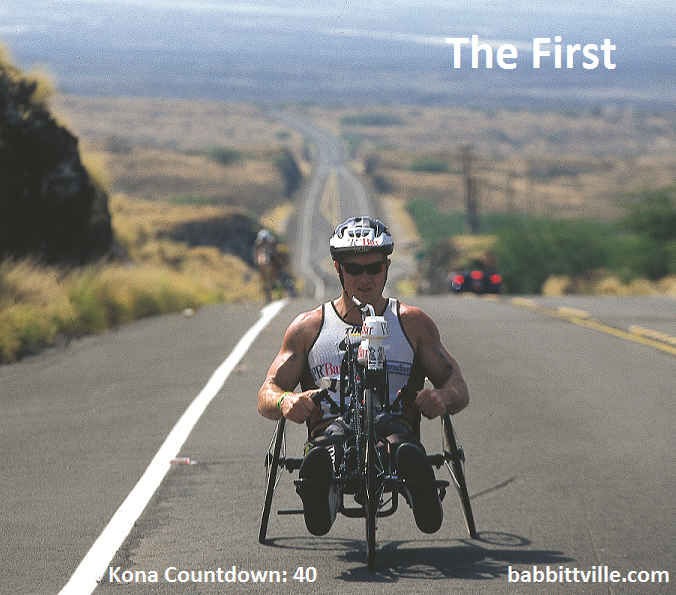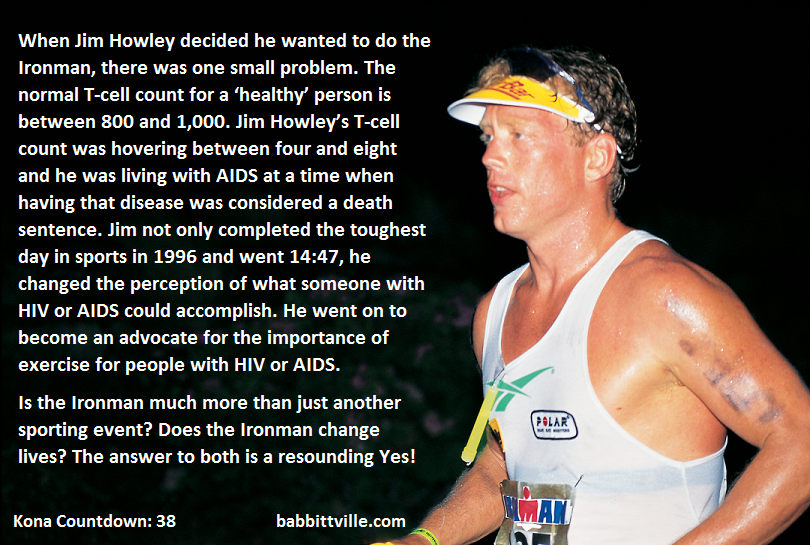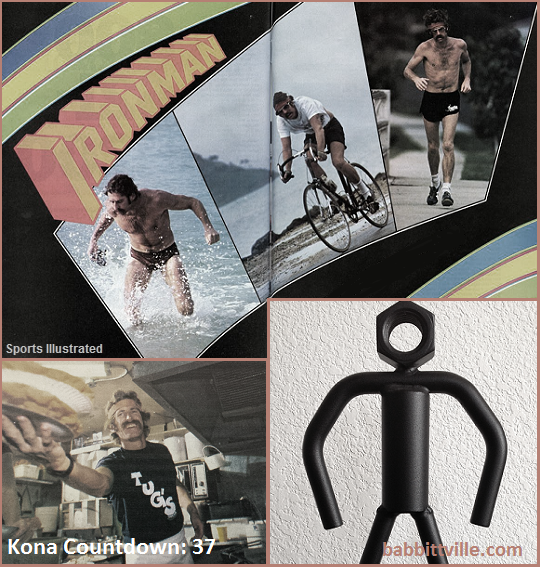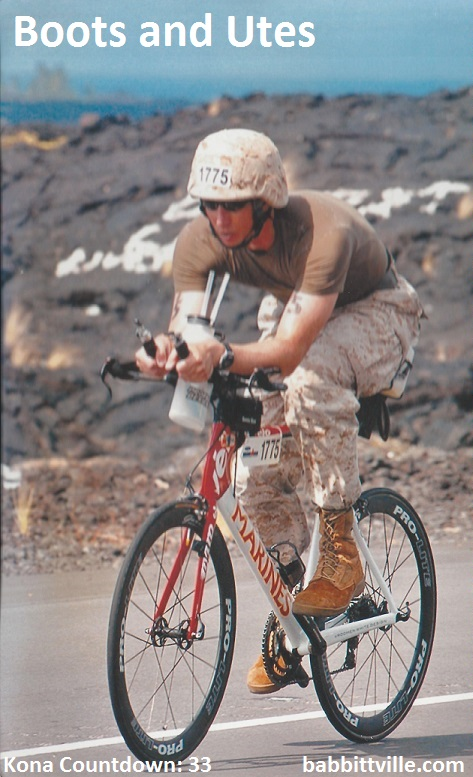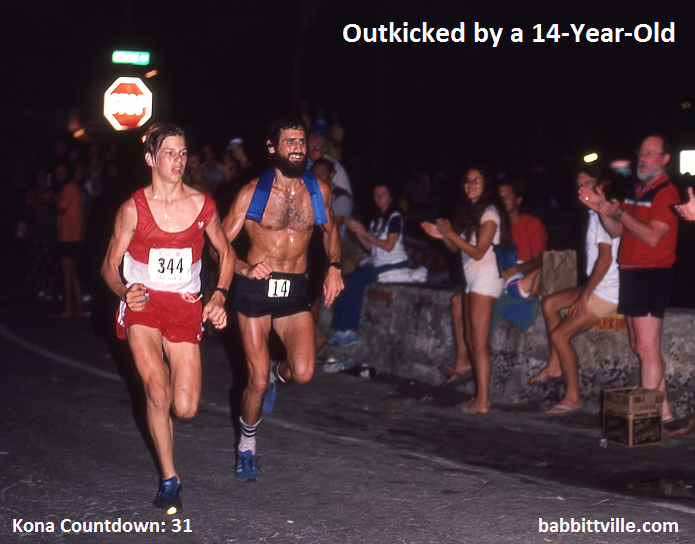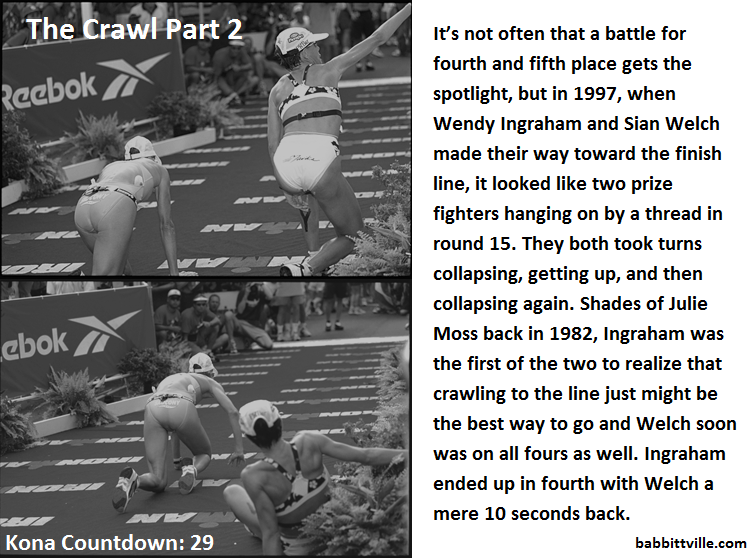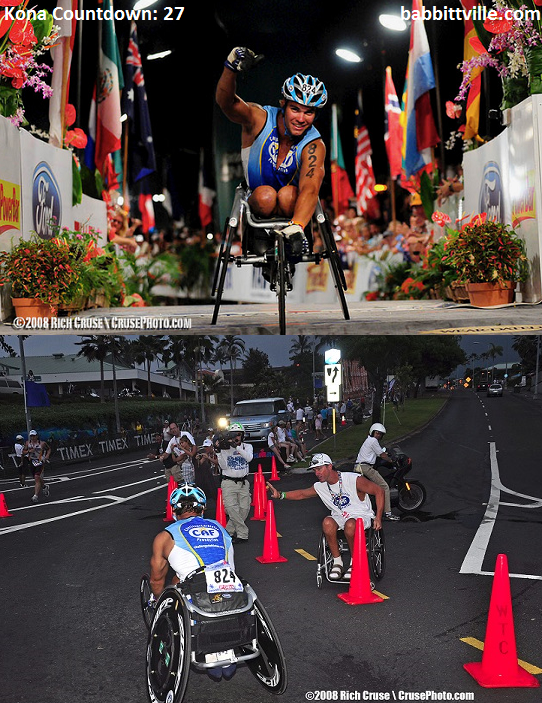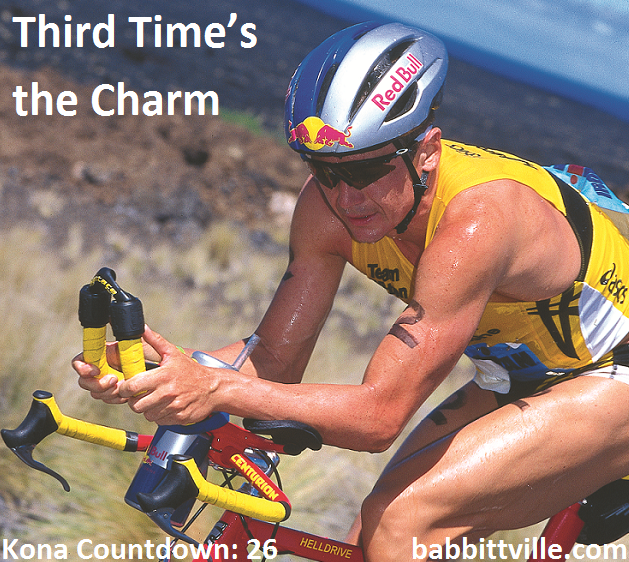For our 2016 Kona Countdown, I’m counting down my 50 Favorite Ironman Hawaii Moments
Here are Moments 50 through 26….
50
49
48
47
46
45
44
Dr. Cory Foulk lives on the Big Island, and a number of years ago he thought that the Ironman was getting a tad too expensive and people were losing site of the fact that it’s not about the cost of the bike you ride, it’s about the toughness of the person riding that bike. So what did he do? He qualified for the race and then rolled in his 65-pound Schwinn Typhoon that he had bought for $25. When he got to the transition area, he was told he couldn’t bring a bike in that had a kickstand on it. He took the kickstand off, but then had to put it back on when the officials realized his tires were too thick to fit into the bike rack. He came out of the swim, put on his Hawaiian shirt, and rode 112 miles barefoot on his cruiser bike that had only one gear. He made all of the cut off times that day and proved that it’s the athlete that matters at the Ironman, not what that athlete spends on equipment.
Interesting side note: There is a rule now that you cannot ride a cruiser bike at the Ironman Triathlon World Championship. We call that TCFR, The Cory Foulk Rule!
43
In 1980 Dave Scott came to the Ironman for the first time and won the race. One of the coolest images from that last race on Oahu is not of Scott winning the first of his six titles or of his foot duct-taped into his pedal. To me the lasting image is of Dave’s parents, Verne and Dot, following their son in a borrowed station wagon with a spare BIKE strapped to the roof of the car. How cool is that?
42
When John Howard showed up on the starting line at the 1980 Ironman, it was a huge moment for the Ironman. Howard was a Pan American Games gold medalist in cycling and a three-time Olympian. As the most decorated athlete in the field, he was the overwhelming favorite, primarily because of his cycling prowess. Unfortunately for John, he found out that day that the Ironman is way more than a bike race and, after a 1:51 swim and a 4:13 marathon, Howard left town with a fast bike ride (4:28) and a third place finish. So what did he do? John Howard went to work, and in 1981 during the first Ironman in Kona, he swam 1:11 – 40 minutes faster than the year before – and ran 3:23 – nearly an hour faster than the year before – and became the Ironman Triathlon World Champion. In 1980, John Howard was a great cyclist. A year later he was a great triathlete!
41
40
The First, Part 2: In 1994, Dr. Jon Franks was the first paralyzed athlete to attempt to finish the Ironman using a handcycle and a racing chair. He missed the bike cutoff time in his one and only attempt in Kona. In 1995, John MacLean from Australia gave it a shot and missed the bike cutoff time as well. In 1996, he missed the bike cutoff time, but he was asked to do the marathon in his racing chair anyway just to see that a paralyzed athlete could indeed go under the 17 hour mark. He did.
When John crossed the line, he was given a finisher’s medal. But John’s brother told him that he couldn’t keep the medal because he didn’t make the cutoff time on the bike, so John returned the finisher’s medal.
In 1997, John easily made all of the cutoff times and proved that a paralyzed athlete could finish the toughest day in sports, and that anything and everything is possible at the Ironman Triathlon World Championship.
39
38
37
The sports bible throughout the 60’s, 70’s and 80’s –before ESPN– was Sports Illustrated. When SI showcased the 1979 Ironman with an eight-page feature on the event and San Diego-based tavern owner –and Ironman champion Tom Warren– more people than ever before were introduced to this crazy new event. That article led to the event growing from 15 starters and 12 finishers in 1979, to 108 starters and 95 finishers in 1980. Plus, Tom Warren became the first triathlete to appear on the Johnny Carson Show. When Johnny asked Tom what he received for his win, he handed Johnny the hole-in-the-head trophy that Commander John Collins soldered together. “Hey Tom,” laughed Johnny as he turned the trophy upside down, “There’s a screw missing!”
36
I went over to the 1980 Ironman on Oahu and had no idea what I was in for. This photo is of me right after I finished the 2.4 mile swim. I wore number 3, not because I was seeded, but because I sent my $25 dollar entry fee in third. My bike cost me $75 and I bought it at a police auction. Why was it so cheap? The back end up of the bike had been burned in a fire, so I covered up that end of the bike with duct tape. Since I couldn’t change a flat, I put solid rubber tires on the bike. I also had foam grips on the handlebars, a fuzzy raccoon bike seat cover, a Radio Shack radio bungee-corded to the handlebars and, of course, panniers with a tent and sleeping bag. My plan for race day was to swim 2.4, ride 56 and then camp out, ride back to Honolulu the next morning and then run the marathon. That certainly made more sense to me! But no, these knuckleheads did the whole thing in one day!
READ MORE: Always Keep Moving Forward
35
34
33
William “Wild Bill” Connor came to Kona in 2008 to do the Ironman. His had been a long journey just to start the race since he’d been applying to get in through the Ironman lottery since 1996. He also was racing for a bigger purpose that day. During his four tours of duty in Iraq, he lost a number of good friends. So on race day he dedicated the swim, bike, and run to three of those colleagues. In order to truly honor them, during the bike ride he wore an eight pound combat helmet perched on his head, full length utilities, known as utes, plus his marine-issue boots modified for his Speedplay pedals. His feet went numb 20 miles into the 112 mile bike ride, but he was in luck! Another pair of boots was waiting for him when he started the marathon. “By mile three I had blisters on both feet,” he admitted.
We look at Ironman as a day of sport, a day of entertainment, a day of perseverance, a day of celebration, and a day that proves to each of us how far the human body can be pushed. For Major Conner, he looked at Ironman as a way to honor three heroes and their families.
Which meant that boots and utes were the perfect dress for the occasion.
32
The year was 2004. Christian Sadowsky had gotten into the race through the lottery that year and was having a good day until about mile 105 of the bike ride. That’s when he was hit by a motorcycle and his bike was destroyed. So what did he do? He picked up his shattered bike, tossed it over his shoulder, took off his bike shoes and walked the last seven miles to T2. He ended up finishing the ride/walk in 8:28 and then set off on the marathon. His time at the finish was 16:09 but his message was much more important than numbers on a clock. The Ironman is about dealing with whatever Ironday might dish out, digging deep inside yourself and finishing what you start, no matter what. No one exemplifies that better than Christian Sadowsky.
31
The year is 1981 and I’m out on the marathon course racing with my blue Bone Phones on, the predecessor of both the Walkman and the iPod. Listening to music throughout 138.2 miles of hell? Yes please!
As we headed toward the finish line, a young man named Rob Englehardt, who I had met earlier in the week and become friendly with, caught me and we trotted along the Queen K Highway together.
Robin would go on to play football at Stanford. “It was a lot more fun to knock the crap out of someone than to sit on a bike seat for seven hours,” he confessed to me years later.
Later in life he would become a movie producer, but in 1981 he was a 14 year old kid racing the Ironman before the rule was changed that you have to be 18 to race Kona.
Hence the issue I was dealing with. I was between a rock and a hard spot. If I out-sprinted Rob, I basically just ran away from a 14 year old. If he out-sprinted me, I just lost to a 14 year old. That’s what we call a lose-lose situation
As I was having this discussion with myself, Rob noticed that the finish was about 200 yards away and simply shifted into that teenager gear that most of us simply don’t have anymore.
Our final times? Robin Englehardt: 13:54:53 Bob Babbitt: 13:54:54.
That is correct. I was outkicked by a 14 year old.
So I’ve got that going for me…which is nice!
30: Chicken Soup and a Glow Stick
Aussie Chris Legh had won north of 60 races in his career including Ironman California in 2000 and Ironman Coeur d’Alene in 2004. He is probably best known in Kona for collapsing within 50 yards of the finish line in 1997. His system had shut down late in the race due to dehydration and he ended up in the hospital having a portion of his large intestine removed.
In 2001, he was racing Kona again and with 60K to go on the bike he was coughing up blood. “When I got off the bike, I couldn’t run,” he remembers. “I walked along Ali’i Drive picking flowers off the trees. When I tried to run, the coughing would start and my heart rate would skyrocket. So I walked.”
When he got to the Queen K, he was able to run. But then he spotted the messenger of doom, the woman who doles out the glow sticks to those Ironman hopefuls who are probably going to finish after dark.
It goes without saying that pros were not expected to need a glow stick.
Chris also found out that the late night aid stations, which most pros never see, are pretty well stocked. “They handed me some bread and chicken soup, and it tasted really good,” Legh admitted.
He connected with an age grouper who was a fellow Aussie. “He would pass me on the uphills and I would get him on the downhills,” he recalls. During the last mile his new buddy hit the wall, so Legh pushed him on the butt to keep him moving.
A hundred yards from the finish, Legh’s buddy took off like he was shot out of a cannon. Legh went after him, his glow stick bouncing on his chest.
The two ended up with identical times of 11:43:35 and Legh took 675th place. “I out leaned him,” says Legh laughing. “Through the years of racing you learn that when things turn to crap, you simply have to make the best of it.”
29
28: The Promise
Dustin Brady met Michelle Weiser, the woman who would become his fiancé, while working at Shimano. Two years into their relationship, Michelle was diagnosed with stage II breast cancer. The cancer then metastasized into her lungs and it became, stage IV, the worst possible scenario.
Michelle had once told Dustin while they were watching finishers late at night in Kona that he should do that race someday.
When Michelle knew she didn’t have long to live, and was asking Dustin what he was going to do when she was gone, he blurted out that he was going to complete an Ironman for her and for himself. When she started to tear up, he moved in to hug her. She put up her hand to stop him. “Do you promise?” she asked. Dustin shook her hand and told her it was a promise.
Michelle passed away on July 5, 2010.
When Dustin came to Kona to race on October 8, 2011, he carried Michelle’s ashes with him in a small container. He took the container out at the top of Palani and kept it in his right hand for the last 1.2 miles of the marathon.
He finished in 16:40:01 and went straight down to the beach where his day had begun nearly 17 hours earlier, waded out into the ocean, and scattered Michelle’s ashes into the surf.
“We spent the entire day together and I fulfilled my promise,” he says. “Then it was time to say goodbye.”
27
David and Ricky: David Bailey met Ricky James when James was 16 years old and an up-and-coming motocross star. Bailey, a legend in the sport who had been paralyzed in training, worked with top motocross athletes and could tell that this kid Ricky James had it all. He had great looks, a megawatt smile, a need for speed, and he was fearless.
When Ricky James was paralyzed during a race, David Bailey met with Ricky and his parents and served as a mentor. One day, just like David Bailey, Ricky James decided he wanted to give the Ironman a try.
In October of 2008, in his third-ever triathlon and first Ironman, Ricky James went 12:44 in Kona. The two of them trained together pretty much every day, and while the training definitely helped Ricky make it to the most important finish line in sport, it also helped David come back from over a year face down on his belly suffering from pressure sores and other major health issues.
“Training with Ricky was everything in terms of my recovery,” admits Bailey.
So when Ricky James came toward the finish that evening in Kona, Bailey was there to greet him. The Ironman had given Ricky James a purpose and a goal that he desperately needed after being paralyzed. And being connected to Ricky James’ journey pushed David Bailey to get out of the house and to get himself back in the game.
What happened next? David Bailey returned to Kona in 2009, finished second in the handcycle division, and went 11:35:38.
26
In 1995, Germany’s Thomas Hellriegel came out of the ocean three and a half minutes down to five-time champion Mark Allen. Then he out split Allen on the bike 4:29:37 to 4:46:35. When you add it all up, Hellriegel had a lead going into the marathon of over 13 minutes.
Hellriegel followed that up with a 2:58:05 marathon, which should have sealed the deal.
But Allen had other ideas, put together a 2:42:09 marathon, caught Hellriegel at about mile 22 and in his final race, at the age of 37, he won his sixth title with Hellriegel in second.
In 1996, Hellriegel again put together a great race, this time going 4:24:50 for the ride, running 2:46:55 for the marathon and posted a time of 8:06:07, which would have broken Mark Allen’s course record of 8:07:45 that he set in 1993.
One problem. Luc Van Lierde from Belgium, despite getting a three minute penalty and despite never having run a marathon or completed an Ironman before, put together a 2:41:48 marathon, set the new course record of 8:04:08, and left Mr. Hellriegel once again in second place.
Finally, in 1997, with a slower time than he posted in both 1995 and 1996, Hellriegel became the first German to win the Ironman World Championship and, ironically, with Jurgen Zack in second and Lother Leder in third, he led a German sweep.
View the Top 25 here


